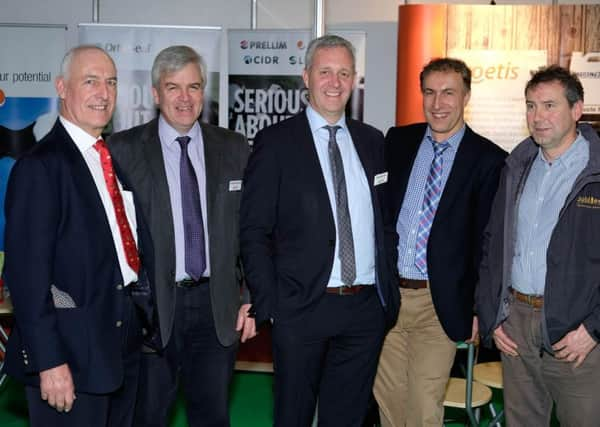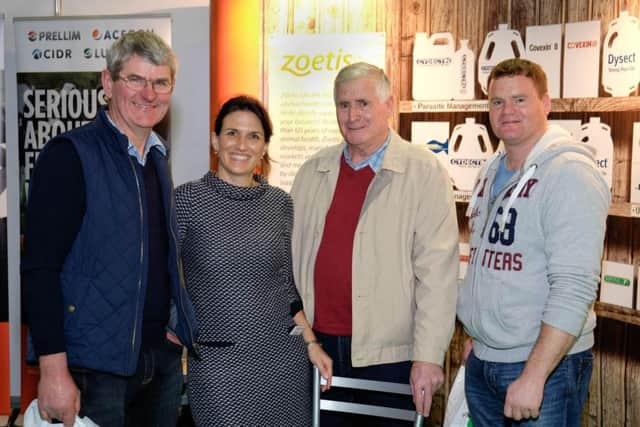Calf rearing, mastitis and fertility '“ The topics discussed at Winter Fair


She said: “Farmers want to realise the opportunities for increasing profit margins through improved heifer rearing. The average cost to rear a replacement heifer is in the region of £2,000 per heifer. In a 100 cow herd with a 30% replacement rate and a yield of 7,500 litres per cow this equates to a cost of 6 pence per litre. There is a significant range in rearing costs with the top 25% CAFRE benchmarkers achieving an average rearing cost of £1,500 per head. The Northern Ireland average for calving heifers is 33 months so there is room for a marked improvement.”
Aurelie added: “The top farms focus closely on all aspects of the heifer rearing enterprise such as careful management of calves from birth through to weaning to reduce disease risks. Calves can be vaccinated against the two key respiratory viruses from nine days of age with Rispoval® IntraNasal which will protect them for 12 weeks against BRSv and Pi3v, ensuring calves are covered through the critical pre-weaning period when poor respiratory health can impact growth rates, age at first calving and subsequent milk yields.
Advertisement
Hide AdAdvertisement
Hide Ad“UK research has shown that high calf growth rates from 0-9 months of age, leading to excellent fertility of maiden heifers and calving at 21-23 months resulted in survival rates of 80% from first calving to five years of age, and a total milk production of 24,000 litres over five years from birth. Heifers calving at 30 months as a result of poor calf growth rates and fertility ended up with an average milk production of 8,000 litres over five years and a survival rate of only 30%.”


Mastitis prevention and industry aims to reduce the use of antibiotics in animals prompted a number of queries on teat sealants. Aurelie states that for mastitis prevention during the dry period the use of a teat sealant on all cows is recommended. An internal teat sealant imitates the cow’s natural keratin plug preventing mastitis-causing bacteria from entering the teat during the entire dry period. The teat sealant, OrbeSeal® has been tested for use with or without an antibiotic and is licensed for use on its own in uninfected animals. Farmers have relied on OrbeSeal® for more than 10 years to prevent mastitis infections and OrbeSeal® consistently achieves at least 35% reduction in clinical mastitis incidence.
For teat sealants to be fully effective an important aspect is the hygiene on the farm and in particular the hygienic procedure required when inserting a teat sealant. There are detailed instructions for this procedure which farmers were keen to discuss at the Winter Fair.
Aurelie emphasised: “Saving one case of clinical mastitis justifies the cost of the sealant.”
Advertisement
Hide AdAdvertisement
Hide AdHigh yielding cows which do not always display signs of heat combined with busy workloads give farmers little opportunity to AI cows at the best possible time. While heat detection aids are being used with some success, breeding protocols are becoming more popular in cattle fertility improvement programmes.


Breeding protocols can be used from the start of the voluntary waiting period (generally 42 days) or can be used after a period of natural heat detection possibly in combination with heat detection aids (eg start using protocols in cows not seen in heat 80 days after calving).
Going one step further, control of the oestrus cycle by a breeding protocol synchronises the cow’s ovulation and heat and can eliminate the need for heat detection. Aurelie states that farmers are interested in breeding protocols but are often not familiar with all of the various combinations and situations in which they can be used. Breeding protocols including the hormones GnRH, PGF2 and progesterone can be used in both cycling and non-cycling cows and heifers in combination with heat detection or fixed time AI. This can help farmers achieve a 100% submission rate, resulting in an increased pregnancy rate, tighter calving pattern and better productivity.
Dairy farmers should consult their vet regarding the use of hormones such as GnRH (e.g.Acegon®), PGF2 (eg Prellim®) and progesterone (CIDR®).